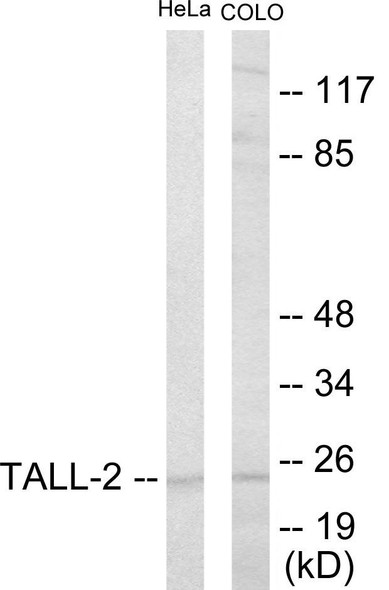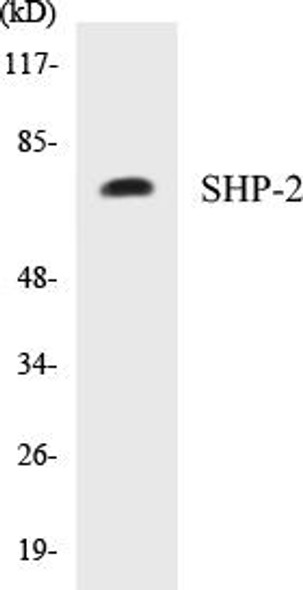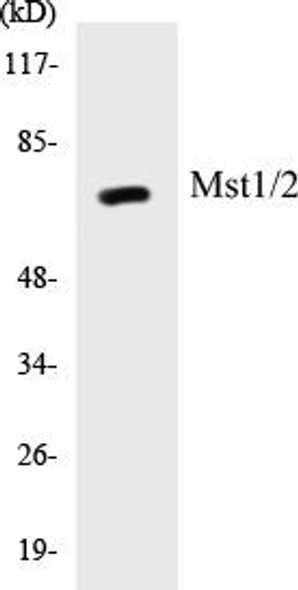EGR1/2 Colorimetric Cell-Based ELISA
- SKU:
- CBCAB00982
- Product Type:
- ELISA Kit
- ELISA Type:
- Cell Based
- Research Area:
- Cell Biology
- Reactivity:
- Human
- Mouse
- Rat
- Detection Method:
- Colorimetric
Description
EGR1/2 Colorimetric Cell-Based ELISA
The EGR1 2-Colorimetric Cell-Based ELISA Kit is a cutting-edge assay designed for the accurate and reliable detection of EGR1 protein levels in cell lysates and tissue homogenates. This kit offers high sensitivity and specificity, providing researchers with precise and reproducible results for a variety of cellular and molecular biology studies.EGR1, also known as Early Growth Response 1, is a transcription factor that plays a key role in regulating gene expression in response to various stimuli. It is involved in a wide range of cellular processes, including cell growth, differentiation, and apoptosis.
Dysregulation of EGR1 expression has been linked to various diseases, such as cancer, cardiovascular disorders, and inflammatory conditions, making it a valuable target for research and potential therapeutic interventions.With its advanced technology and user-friendly protocols, the EGR1 2-Colorimetric Cell-Based ELISA Kit is an essential tool for studying the role of EGR1 in cellular signaling pathways, disease development, and therapeutic target identification. Upgrade your research capabilities with this innovative kit and unlock new insights into the complex world of molecular biology.
| Product Name: | EGR1/2 Colorimetric Cell-Based ELISA |
| Product Code: | CBCAB00982 |
| ELISA Type: | Cell-Based |
| Target: | EGR1/2 |
| Reactivity: | Human, Mouse, Rat |
| Dynamic Range: | > 5000 Cells |
| Detection Method: | Colorimetric 450 nmStorage/Stability:4°C/6 Months |
| Format: | 96-Well Microplate |
The EGR1/2 Colorimetric Cell-Based ELISA Kit is a convenient, lysate-free, high throughput and sensitive assay kit that can detect EGR1/2 protein expression profile in cells. The kit can be used for measuring the relative amounts of EGR1/2 in cultured cells as well as screening for the effects that various treatments, inhibitors (ie siRNA or chemicals), or activators have on EGR1/2.
Qualitative determination of EGR1/2 concentration is achieved by an indirect ELISA format. In essence, EGR1/2 is captured by EGR1/2-specific primary antibodies while the HRP-conjugated secondary antibodies bind the Fc region of the primary antibody. Through this binding, the HRP enzyme conjugated to the secondary antibody can catalyze a colorimetric reaction upon substrate addition. Due to the qualitative nature of the Cell-Based ELISA, multiple normalization methods are needed:
| 1. | A monoclonal antibody specific for human GAPDH is included to serve as an internal positive control in normalizing the target absorbance values. |
| 2. | Following the colorimetric measurement of HRP activity via substrate addition, the Crystal Violet whole-cell staining method may be used to determine cell density. After staining, the results can be analysed by normalizing the absorbance values to cell amounts, by which the plating difference can be adjusted. |
| Database Information: | Gene ID: 1958/1959, UniProt ID: P18146/P11161, OMIM: 128990/129010, Unigene: Hs.326035/Hs.1395 |
| Gene Symbol: | EGR1 |
| Sub Type: | None |
| UniProt Protein Function: | EGR1: Transcriptional regulator. Recognizes and binds to the DNA sequence 5'-CGCCCCCGC-3'(EGR-site). Activates the transcription of target genes whose products are required for mitogenesis and differentiation. By growth factors. Belongs to the EGR C2H2-type zinc-finger protein family. |
| UniProt Protein Details: | Protein type:DNA-binding; C2H2-type zinc finger protein; Transcription factor Chromosomal Location of Human Ortholog: 5q31.1 Cellular Component: nucleoplasm; cytoplasm; nucleus Molecular Function:histone acetyltransferase binding; protein binding; DNA binding; sequence-specific DNA binding; metal ion binding; double-stranded DNA binding; transcription factor binding; transcription factor activity Biological Process: regulation of long-term neuronal synaptic plasticity; circadian rhythm; response to nutrient levels; transcription from RNA polymerase II promoter; cytokine and chemokine mediated signaling pathway; positive regulation of transcription, DNA-dependent; response to amphetamine; negative regulation of transcription from RNA polymerase II promoter; response to cocaine; BMP signaling pathway; response to ethanol; learning and/or memory; cellular response to insulin stimulus; positive regulation of neuron apoptosis; response to glucose stimulus; oligodendrocyte differentiation; positive regulation of transcription from RNA polymerase II promoter; response to electrical stimulus; T cell differentiation; regulation of protein sumoylation; negative regulation of apoptosis |
| NCBI Summary: | The protein encoded by this gene belongs to the EGR family of C2H2-type zinc-finger proteins. It is a nuclear protein and functions as a transcriptional regulator. The products of target genes it activates are required for differentitation and mitogenesis. Studies suggest this is a cancer suppressor gene. [provided by RefSeq, Dec 2014] |
| UniProt Code: | P18146 |
| NCBI GenInfo Identifier: | 119242 |
| NCBI Gene ID: | 1958 |
| NCBI Accession: | P18146.1 |
| UniProt Related Accession: | P18146 |
| Molecular Weight: | 543 |
| NCBI Full Name: | Early growth response protein 1 |
| NCBI Synonym Full Names: | early growth response 1 |
| NCBI Official Symbol: | EGR1 |
| NCBI Official Synonym Symbols: | TIS8; AT225; G0S30; NGFI-A; ZNF225; KROX-24; ZIF-268 |
| NCBI Protein Information: | early growth response protein 1; EGR-1; zinc finger protein 225; transcription factor ETR103; transcription factor Zif268; zinc finger protein Krox-24; nerve growth factor-induced protein A |
| UniProt Protein Name: | Early growth response protein 1 |
| UniProt Synonym Protein Names: | AT225; Nerve growth factor-induced protein A; NGFI-A; Transcription factor ETR103; Transcription factor Zif268; Zinc finger protein 225; Zinc finger protein Krox-24 |
| Protein Family: | Early growth response protein |
| UniProt Gene Name: | EGR1 |
| UniProt Entry Name: | EGR1_HUMAN |
| Component | Quantity |
| 96-Well Cell Culture Clear-Bottom Microplate | 2 plates |
| 10X TBS | 24 mL |
| Quenching Buffer | 24 mL |
| Blocking Buffer | 50 mL |
| 15X Wash Buffer | 50 mL |
| Primary Antibody Diluent | 12 mL |
| 100x Anti-Phospho Target Antibody | 60 µL |
| 100x Anti-Target Antibody | 60 µL |
| Anti-GAPDH Antibody | 60 µL |
| HRP-Conjugated Anti-Rabbit IgG Antibody | 12 mL |
| HRP-Conjugated Anti-Mouse IgG Antibody | 12 mL |
| SDS Solution | 12 mL |
| Stop Solution | 24 mL |
| Ready-to-Use Substrate | 12 mL |
| Crystal Violet Solution | 12 mL |
| Adhesive Plate Seals | 2 seals |
The following materials and/or equipment are NOT provided in this kit but are necessary to successfully conduct the experiment:
- Microplate reader able to measure absorbance at 450 nm and/or 595 nm for Crystal Violet Cell Staining (Optional)
- Micropipettes with capability of measuring volumes ranging from 1 µL to 1 ml
- 37% formaldehyde (Sigma Cat# F-8775) or formaldehyde from other sources
- Squirt bottle, manifold dispenser, multichannel pipette reservoir or automated microplate washer
- Graph paper or computer software capable of generating or displaying logarithmic functions
- Absorbent papers or vacuum aspirator
- Test tubes or microfuge tubes capable of storing ≥1 ml
- Poly-L-Lysine (Sigma Cat# P4832 for suspension cells)
- Orbital shaker (optional)
- Deionized or sterile water
*Note: Protocols are specific to each batch/lot. For the correct instructions please follow the protocol included in your kit.
| Step | Procedure |
| 1. | Seed 200 µL of 20,000 adherent cells in culture medium in each well of a 96-well plate. The plates included in the kit are sterile and treated for cell culture. For suspension cells and loosely attached cells, coat the plates with 100 µL of 10 µg/ml Poly-L-Lysine (not included) to each well of a 96-well plate for 30 minutes at 37°C prior to adding cells. |
| 2. | Incubate the cells for overnight at 37°C, 5% CO2. |
| 3. | Treat the cells as desired. |
| 4. | Remove the cell culture medium and rinse with 200 µL of 1x TBS, twice. |
| 5. | Fix the cells by incubating with 100 µL of Fixing Solution for 20 minutes at room temperature. The 4% formaldehyde is used for adherent cells and 8% formaldehyde is used for suspension cells and loosely attached cells. |
| 6. | Remove the Fixing Solution and wash the plate 3 times with 200 µL 1x Wash Buffer for five minutes each time with gentle shaking on the orbital shaker. The plate can be stored at 4°C for a week. |
| 7. | Add 100 µL of Quenching Buffer and incubate for 20 minutes at room temperature. |
| 8. | Wash the plate 3 times with 1x Wash Buffer for 5 minutes each time. |
| 9. | Add 200 µL of Blocking Buffer and incubate for 1 hour at room temperature. |
| 10. | Wash 3 times with 200 µL of 1x Wash Buffer for 5 minutes each time. |
| 11. | Add 50 µL of 1x primary antibodies (Anti-EGR1/2 Antibody and/or Anti-GAPDH Antibody) to the corresponding wells, cover with Parafilm and incubate for 16 hours (overnight) at 4°C. If the target expression is known to be high, incubate for 2 hours at room temperature. |
| 12. | Wash 3 times with 200 µL of 1x Wash Buffer for 5 minutes each time. |
| 13. | Add 50 µL of 1x secondary antibodies (HRP-Conjugated AntiRabbit IgG Antibody or HRP-Conjugated Anti-Mouse IgG Antibody) to corresponding wells and incubate for 1.5 hours at room temperature. |
| 14. | Wash 3 times with 200 µL of 1x Wash Buffer for 5 minutes each time. |
| 15. | Add 50 µL of Ready-to-Use Substrate to each well and incubate for 30 minutes at room temperature in the dark. |
| 16. | Add 50 µL of Stop Solution to each well and read OD at 450 nm immediately using the microplate reader. |
(Additional Crystal Violet staining may be performed if desired – details of this may be found in the kit technical manual.)










